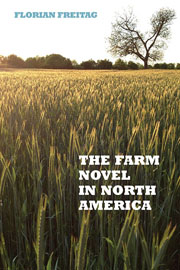 The Farm Novel in North America
The Farm Novel in North America Book contents
- Frontmatter
- Contents
- Acknowledgments
- Introduction
- 1 Surveying the Fields
- 2 Early Sowings: St. John de Crèvecocur's “History of Andrew, the Hebridean,” Patrice Lacombe's La terre paternelle, and Susanna Moodie's Roughing It in the Bush
- 3 Laws of Nature: Frank Norris's The Octopus, Albert Laberge's La Scouine, and Frederick Philip Grove's Settlers of the Marsh
- 4 New World Demeters: Willa Cather's O Pioneers!, Louis Hémon's Maria Chapdelaine, and Martha Ostenso's Wild Geese
- 5 Rich Harvests: Joseph Kirkland's Zury: The Meanest Man in Spring County, Claude-Henri Grignon's Un homme et son péché, and Frederick Philp Grove's Fruits of the Earth
- 6 Fields of Crisis: John Steinbeck's The Grapes of Wrath, Félix-Antoine Savard's Menaud, maître-draveur, and Robert J. C. Stead's Grain
- 7 The Cycle of Seasons: Louis Bromfield's The Farm, Ringuet's Trente arpents, and Grace Campbell's The Higher Hill
- Epilogue
- Works Cited
- Index
4 - New World Demeters: Willa Cather's O Pioneers!, Louis Hémon's Maria Chapdelaine, and Martha Ostenso's Wild Geese
Published online by Cambridge University Press: 05 December 2013
- Frontmatter
- Contents
- Acknowledgments
- Introduction
- 1 Surveying the Fields
- 2 Early Sowings: St. John de Crèvecocur's “History of Andrew, the Hebridean,” Patrice Lacombe's La terre paternelle, and Susanna Moodie's Roughing It in the Bush
- 3 Laws of Nature: Frank Norris's The Octopus, Albert Laberge's La Scouine, and Frederick Philip Grove's Settlers of the Marsh
- 4 New World Demeters: Willa Cather's O Pioneers!, Louis Hémon's Maria Chapdelaine, and Martha Ostenso's Wild Geese
- 5 Rich Harvests: Joseph Kirkland's Zury: The Meanest Man in Spring County, Claude-Henri Grignon's Un homme et son péché, and Frederick Philp Grove's Fruits of the Earth
- 6 Fields of Crisis: John Steinbeck's The Grapes of Wrath, Félix-Antoine Savard's Menaud, maître-draveur, and Robert J. C. Stead's Grain
- 7 The Cycle of Seasons: Louis Bromfield's The Farm, Ringuet's Trente arpents, and Grace Campbell's The Higher Hill
- Epilogue
- Works Cited
- Index
Summary
Spurred by debates and new ideas about women, their work, and their role within society, North American farm novels at the beginning of the twentieth century started to investigate more closely the role of women on the farm. Starting in the early 1900s and especially during the 1910s and 1920s, the genre increasingly focused on female protagonists and created new fictional types and plot formulas especially around unmarried women characters who dedicate their lives to the soil.
In the United States, single women farmers already appeared in Eleanor Gates's The Plow-Woman (1906) and Hamlin Garland's The Moccasin Ranch: A Story of Dakota (1909); but it was Willa Cather's O Pioneers! ([1913] 1993), with its protagonist Alexandra Bergson, that featured the clearest and perhaps also the most memorable example of the figure of pioneer heroine in American farm fiction. English Canadian rural idylls, such as Arthur Stringer's The Prairie Wife (1915) and particularly Evah McKowan's Janet of Kootenay (1919), also drew on this new fictional type and simultaneously added elements of the so-called “new woman” to it. One year after Cather's novel, Louis Hémon's Maria Chapdelaine ([1914] 1921) introduced a new plot formula to the French Canadian farm novel, which focused on a young woman's choice between different suitors who were each inextricably linked with one of the roman de la terre's deterministic geographies. Slowly but surely, this new plot formula would be both imitated and reconfigured by later works, such as Harry Bernard's La terre vivante (1925) and Félix-Antoine Savard's Menaud, maître-draveur ([1937] 1992).
- Type
- Chapter
- Information
- The Farm Novel in North AmericaGenre and Nation in the United States, English Canada, and French Canada, 1845-1945, pp. 147 - 185Publisher: Boydell & BrewerPrint publication year: 2013
